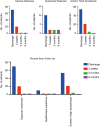Complications associated with L4-5 anterior retroperitoneal trans-psoas interbody fusion: a single institution series
- PMID: 33102893
- PMCID: PMC7548830
- DOI: 10.21037/jss-20-579
Complications associated with L4-5 anterior retroperitoneal trans-psoas interbody fusion: a single institution series
Abstract
Background: Lateral lumbar interbody fusion (LLIF), first described in the literature in 2006 by Ozgur et al., involves direct access to the lateral disc space via a retroperitoneal trans-psoas tubular approach. Neuromonitoring is vital during this approach since the surgical corridor traverses the psoas muscle where the lumbar plexus lies, risking injury to the lumbosacral plexus that could result in sensory or motor deficits. The risk of neurologic injury is especially higher at L4-5 due to the anatomy of the plexus at this level. Here we report our single-center clinical experience with L4-5 LLIF.
Methods: A retrospective chart review of all patients who underwent an L4-5 LLIF between May 2016 and March 2019 was performed. Baseline demographics and clinical characteristics, such as body mass index (BMI), medical comorbidities, surgical history, tobacco status, operative time and blood loss, length of stay (LOS), and post-op complications were recorded.
Results: A total of 220 (58% female and 42% male) cases were reviewed. The most common presenting pathology was spondylolisthesis. The average age, BMI, operative time, blood loss, and LOS were 64.6 years, 29 kg/m2, 214 min, 75 cc, and 2.5 days respectively. A review of post-operative neurologic deficits revealed 31.4% transient hip flexor weakness and 4.5% quadricep weakness on the approach side. At 3-week follow-up, 9.1% of patients experienced mild hip flexor weakness (4 or 4+/5), 0.9% reported mild quadricep weakness, and 9.5% reported anterior thigh dysesthesias; 93.2% of patients were discharged home and 2.3% were readmitted within the first 30 days post discharge. Female sex, higher BMI and longer operative time were associated with hip flexor weakness.
Conclusions: LLIF at L4-5 is a safe, feasible, and versatile approach to the lumbar spine with an acceptable approach-related sensory and motor neurologic complication rates.
Keywords: Complications; lateral interbody fusion; lumbar fusion; minimally invasive spine surgery (MISS); trans-psoas approach.
2020 Journal of Spine Surgery. All rights reserved.
Conflict of interest statement
Conflict of Interest: All authors have completed the ICMJE uniform disclosure form (available at http://dx.doi.org/10.21037/jss-20-579). The authors have no conflicts of interest to declare.
Figures


Similar articles
-
Short-term outcomes of lateral lumbar interbody fusion without decompression for the treatment of symptomatic degenerative spondylolisthesis at L4-5.Neurosurg Focus. 2018 Jan;44(1):E6. doi: 10.3171/2017.10.FOCUS17566. Neurosurg Focus. 2018. PMID: 29290128
-
Minimally invasive lateral retroperitoneal transpsoas interbody fusion for L4-5 spondylolisthesis: clinical outcomes.J Neurosurg Spine. 2013 Sep;19(3):314-20. doi: 10.3171/2013.6.SPINE1340. Epub 2013 Jul 26. J Neurosurg Spine. 2013. PMID: 23889186
-
The Oblique Anterolateral Approach to the Lumbar Spine Provides Access to the Lumbar Spine With Few Early Complications.Clin Orthop Relat Res. 2016 Sep;474(9):2020-7. doi: 10.1007/s11999-016-4883-3. Epub 2016 May 9. Clin Orthop Relat Res. 2016. PMID: 27160744 Free PMC article.
-
Oblique Lumbar Interbody Fusion: Technical Aspects, Operative Outcomes, and Complications.World Neurosurg. 2017 Feb;98:113-123. doi: 10.1016/j.wneu.2016.10.074. Epub 2016 Oct 21. World Neurosurg. 2017. PMID: 27777161 Review.
-
Lateral Lumbar Interbody Fusion.Asian Spine J. 2015 Dec;9(6):978-83. doi: 10.4184/asj.2015.9.6.978. Epub 2015 Dec 8. Asian Spine J. 2015. PMID: 26713134 Free PMC article. Review.
Cited by
-
The Evolution of Lateral Lumbar Interbody Fusion: A Journey from Past to Present.Medicina (Kaunas). 2024 Feb 23;60(3):378. doi: 10.3390/medicina60030378. Medicina (Kaunas). 2024. PMID: 38541104 Free PMC article. Review.
-
Complication rates following stand-alone lateral interbody fusion: a single institution series after 10 years of experience.Eur J Orthop Surg Traumatol. 2023 Jul;33(5):2121-2127. doi: 10.1007/s00590-022-03408-7. Epub 2022 Oct 14. Eur J Orthop Surg Traumatol. 2023. PMID: 36239820
-
Towards a More Realistic Appraisal of Complications Following Staged Lateral Lumbar Interbody Fusion: A Single Institution Series.Global Spine J. 2024 Jan;14(1):130-137. doi: 10.1177/21925682221096621. Epub 2022 Apr 21. Global Spine J. 2024. PMID: 35446693 Free PMC article.
-
Comparative Review of Lateral and Oblique Lumbar Interbody Fusion: Technique, Outcomes, and Complications.Int J Spine Surg. 2025 May 12;19(2):246-260. doi: 10.14444/8759. Int J Spine Surg. 2025. PMID: 40341118 Free PMC article.
-
Key Considerations in Surgical Decision-Making on the Side of Approach for Lumbar Lateral Transpsoas Interbody Fusion Techniques.Int J Spine Surg. 2025 May 12;19(2):145-155. doi: 10.14444/8721. Int J Spine Surg. 2025. PMID: 40049726 Free PMC article.
References
LinkOut - more resources
Full Text Sources
Miscellaneous
